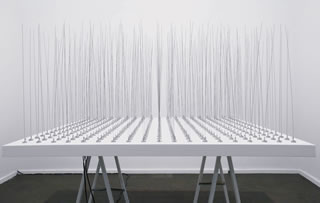Sounding the Depths - Page 5
 |
 |
|
|
|
Trimpin also takes a deeper view of sound art, almost a crusader's view. He inveighs against architects who design spaces with an eye to their visual character but not their aural, and notes how often people fail to hear the sounds that are all about them—like the annoying mechanical hums that are seemingly omnipresent in the modern world.
 |
|
|
He's walked away from some potential exhibition spaces because they've been too noisy for his sculpture to succeed. "Don't you hear that!?" he's asked the curator. The reply? "Oh...that…"
"I cannot have an installation in this environment where there are other sounds going on," Trimpin complains.
"If you are a fish and a boat goes by," he told a recent gathering, "you don't want to be a fish because it's really noisy down there."
Trimpin is far from the first sound artist to worry about sound pollution. Back in the 1970s, the English artist Hugh Davies proposed softer materials be used in roadways to decrease noise, and suggested that cities build 'acoustic parks' to preserve natural sounds.
 |
|
|
Many sound artists view sound as a sacred phenomenon, and see their art as a route to the fundaments of the universe.
One of the 'greatest hits' in the annals of sound art, Alvin Lucier's 'I Am Sitting in a Room,' from 1969, illustrates one theme common to many sound artists—that the space in which sound is heard or seen is an integral part of the artwork. So are the natural sounds that surround us—even the ones we rarely attend to, or even hear.
'I Am Sitting in a Room' also suggests the mystical side of much sound art—the idea that the particular space occupied by performer, art object, and listeners is also the infinite space of the universe.
 |
|
|
In his piece, Lucier, sitting in a room, calmly describes the act of sitting in a room while taping both his description and the sound of the room. Then he plays it back and tapes it again, doing this over and over until the words can no longer be perceived, and all that remains is the natural resonance of the space—a ghostly hum that hints at a cosmic vastness.
Harry Bertoia also saw his art in a mystical light, his son says. Bertoia's sounds ranged from the thunderous tones of his silicon bronze gongs to the quieter tones of his beryllium copper towers
"They had a wonderful sound, very peaceful and soothing, very useful to Harry in his stressful work," Val says. "He cantilevered the rods from the base, and when they touched each other it produced a very beautiful spirit-like sound."
"It was almost like a cosmic communication," Val says, "sounds connected to the universe."
Photos: Toni Gauthier, Paul Moss, Yani Mayeri, Sven Wiederholt, Oliver Dicicco, Lisa Stout, Zimoun, Josh Larios, Troy Tietjen, Sebastian George, Christopher Dant; and courtesy Stanford Lively Arts, Johansson Projects, Artists Rights Society, Gray Area Foundation, Tamara Albaitis, Val Bertoia




